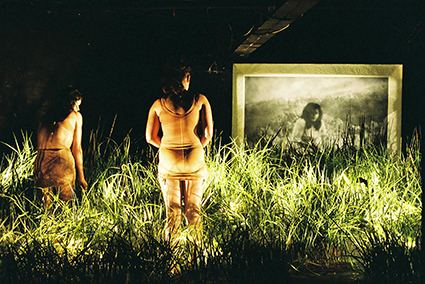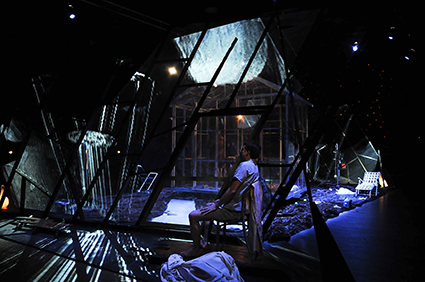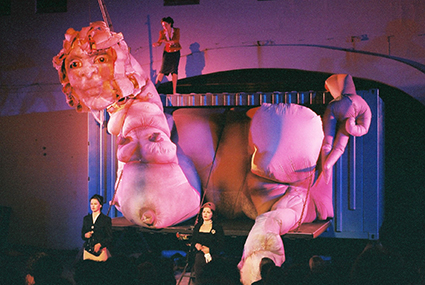The feminine: monstrous, polite, tenacious
Bryoni Trezise: My Darling Patricia

Politely Savage (2005), My Darling Patricia
photo Heidrun Lohr
Politely Savage (2005), My Darling Patricia
It is over 10 years ago now that My Darling Patricia (Clare Britton, Bridget Dolan, Katrina Gill and Halcyon Macleod) boldly dressed the contemporary performance outdoors in what has since become their signature feminist aesthetic. In Dear Pat (2004), three impeccably dressed wartime women plotted out a highly curated sequence of gestural imagining in Bondi’s evening open air, complete with tailored pencil skirt assemblies and tightly crafted pin-curled hair sets. With delicate glances askance and waving from afar, their high-heeled bodies carved out the physical geometries of a nostalgic other-time, long before Mad Men plunged the post-war feminine back into mainstream view.
Dear Pat was the second of the company’s public, site-specific works, building on the character types foregrounded in the domestic spectacle Kissing the Mirror (2003) a year earlier. Positioned in the intimacy of a Petersham caretaker’s apartment, Britton and Macleod physically stuttered as they poured themselves tea, Macleod’s fine porcelain teetering, Britton hunch-backed and drooling. Where Dear Pat built on the ‘chronotope’ of the post-war woman, these aged women instead envisioned her demise, at once imagining into old age and also seeking through her perspective the gendered traces of a former heyday. Both works ascend to the calamity of a salacious reveal: the old women conduct a slow rooftop embrace with alien-foetus-like puppets (their inner selves, their lost ‘twins’?), and the women in Dear Pat are seduced by a large inflatable multi-titted vision of the monstrous feminine herself.
In both works, this distilled staging of a precisely feminine aesthetic is what enables the company’s feminist politics to take shape. Speaking to Macleod and Britton in the aftermath of their company’s 11-year success—My Darling Patricia has recently drawn itself to a close—it becomes clear that these very productive tensions between inner and outer worlds, working across the dynamics of intimacy and spectacle, have grounded their theatrical vision from the beginning. Britton describes how key early influences in physical as well as visual training from PACT, COFA, Performance Space and Erth, as well as mentors such as Chris Ryan, Robert Lepage and Philippe Genty, landed their practice at “a cross-[roads] between performance and sculpture.” It also becomes clear that this desire to articulate what Macleod emphasises as “a visual language [working] through the performance” is inseparable from the thematic terrain the company has continuously evoked.
Their prize-winning work Politely Savage (2005; R67, p32; RT68, p47;), which interestingly seemed to enfold the dynamics of site-specificity into an enclosed theatre space, fleshed out these duplicities by exploring what Britton describes as an ongoing curiosity in “artifice, or that difference between how something looks and what’s going on inside—people who were performing a version of their lives for other people.” Macleod names this the “polite woman as a type…that need to be nice and polite and pretty” and notes how dramaturgically the polite woman can operate as “a gateway to this other thing: the imagined world, the mythic world.” It is the company’s signature ability to summon the mythic that has resulted in their work often being labelled suburban-gothic and I ask them whether their interest in the monstrous feminine might have in addition opened out a more located investment in a particularly Australian form of gendered experience.

Night Garden (2009) My Darling Patricia
photo Heidrun Lohr
Night Garden (2009) My Darling Patricia
For them, the suburban necessarily resonates with inverse ideas of the internal for how it “brings up those notions of a banal veneer and something subterranean and more interesting and grander underneath.” The suburban gendered experience hinted at in the historical flavour of the post-war trilogy is fleshed out further in Night Garden (2009; RT90, p46) which works with a transverse stage to envision the waking dreamscape of a mother caught in what the audience experiences as both a social and spatial frame. The socio-economic landscape in this work is further drawn into stark relief in Africa (2009; RT 94, p40) where we witness the inverse of the mythic feminine to instead see her brutal domestic reality. Puppet children here focus the child’s perspective of an adult world: adults are only ever seen from the waist down. The monstrous feminine, who in earlier works has been visualised as a vagrant puppet-child-creature—the mythic imagining of female repression itself—is here decidedly not metaphorical. There is no poetic relief cast by the otherness of these puppets, but rather a crushing finality to the fact that their very otherness materialises what is culturally cast aside. The puppets here speak to the monstrous landscape of social disadvantage.
While gendered experience is the subtext of much of My Darling Patricia’s work, their operating context is also explicitly feminist in that it “is trying to actively create more female perspectives and work with female collaborators. Not exclusively. We’ve worked with a lot of lovely men as well. But we’ve definitely tried to have an impact that’s empowering of women,” Britton explains. Macleod adds, “Women in the room have always been in control of the process and of the room and of the artistic vision and of the collaborations,” acknowledging as well that the concepts behind Africa and The Piper were from Sam Routledge. In navigating the evolution of their company aesthetics it is interesting that the seeds planted by their early works evolved to craft two very different theatrical worlds in the latter stages of the company’s life. Posts in the Paddock (2011; RT107, p38) and The Piper (2014); both abandon this early interest in the mythic female to respectively contemplate historical and children’s perspectives.

Dear Pat, My Darling Patricia (2004)
photo courtesy the artists
Dear Pat, My Darling Patricia (2004)
As children enter the frame (Macleod is currently nursing her second child and Britton had her son just after Politely Savage closed), I ask whether they’ve experienced gender disadvantage in accessing funding for their works; they mention their proposals to funding bodies about establishing a childcare fund to support interstate collaborations and touring works. As artists, they need childcare that covers intensive periods of work when living away from home. Britton explains the brutal pragmatics of the situation as a compromise between earning less than enough versus nothing at all: “You can either compromise on childcare [budget] or put in an application that’s less competitive because it’s more expensive.” In this context, two of the company’s founding members, (Katrina Gill and Bridget Dolan) were challenged by the demands of interstate collaboration with young children. Dolan is now a practicing painter and Gill is on a similar trajectory. At the same time, Macleod and Britton also acknowledge that these concerns might now be dwarfed by larger threats to any form of experimental practice given the recently proposed cuts to arts funding in Australia. Macleod hence notes the benefits of paving the autonomous path that they’ve set for themselves, where “wanting to create experimental projects and realise your own ideas and not wanting to answer to someone else” is a privilege.
All of this might lead you to think that Britton and Macleod could be in need of a rest, but speaking to them on the cusp of new horizons, these women are already fleshing out their next trajectories. For Macleod an interest in textuality is taking her to a collaborative development in Barbados, and for Britton, an interest in Australia’s broken relationship to its past is currently taking her rowing down the Cooks River. In addition, The Piper will be touring to Edinburgh Fringe Festival in August and they are also looking to remount their most recent work Mantle, which premiered at Campbelltown Arts Centre late last year. Perhaps rather than monstrous, these women have found a ‘feminine’ of a different order: both tenacious and steady, to say the least.
RealTime issue #127 June-July 2015 pg. 38-39






